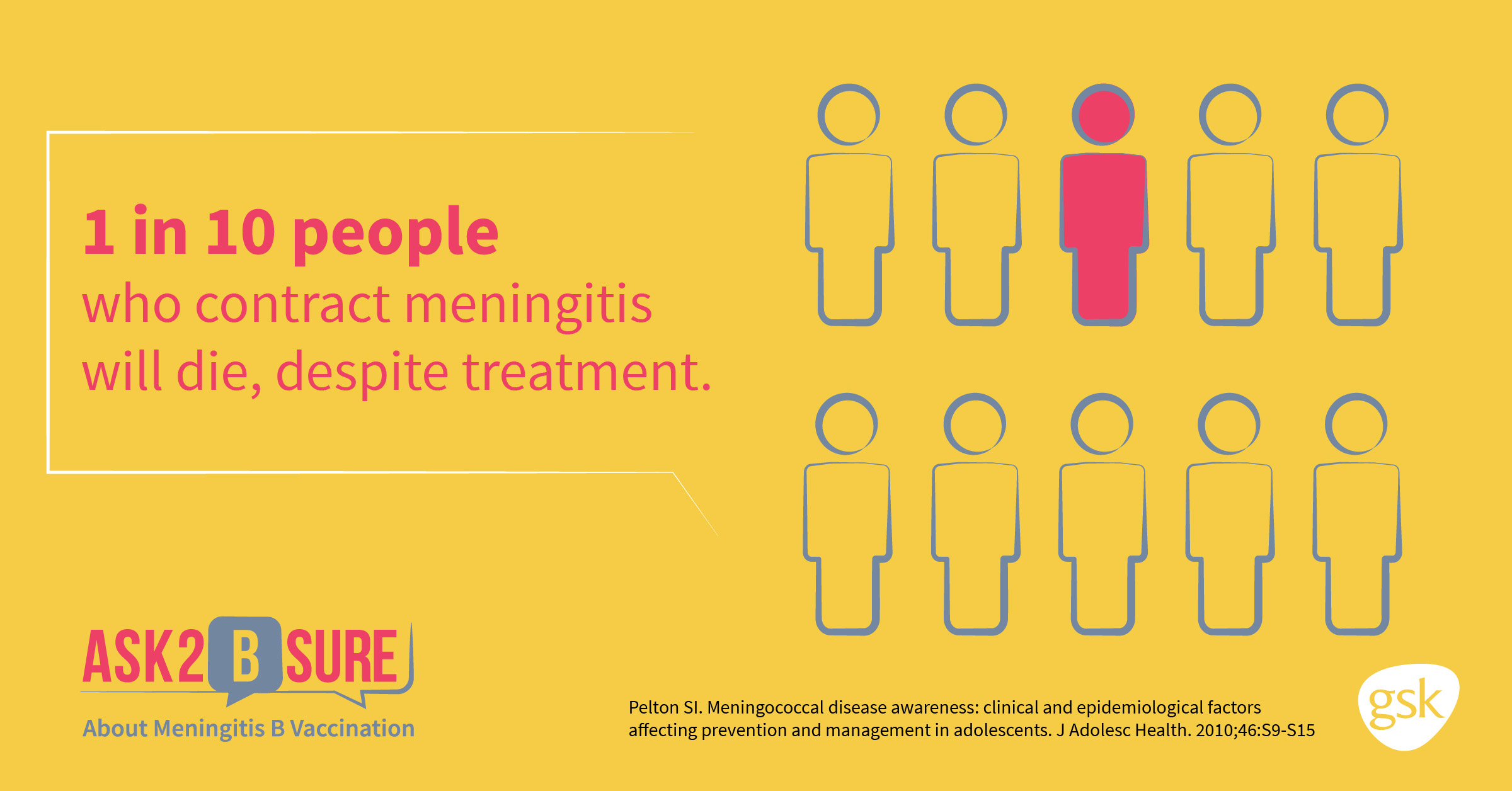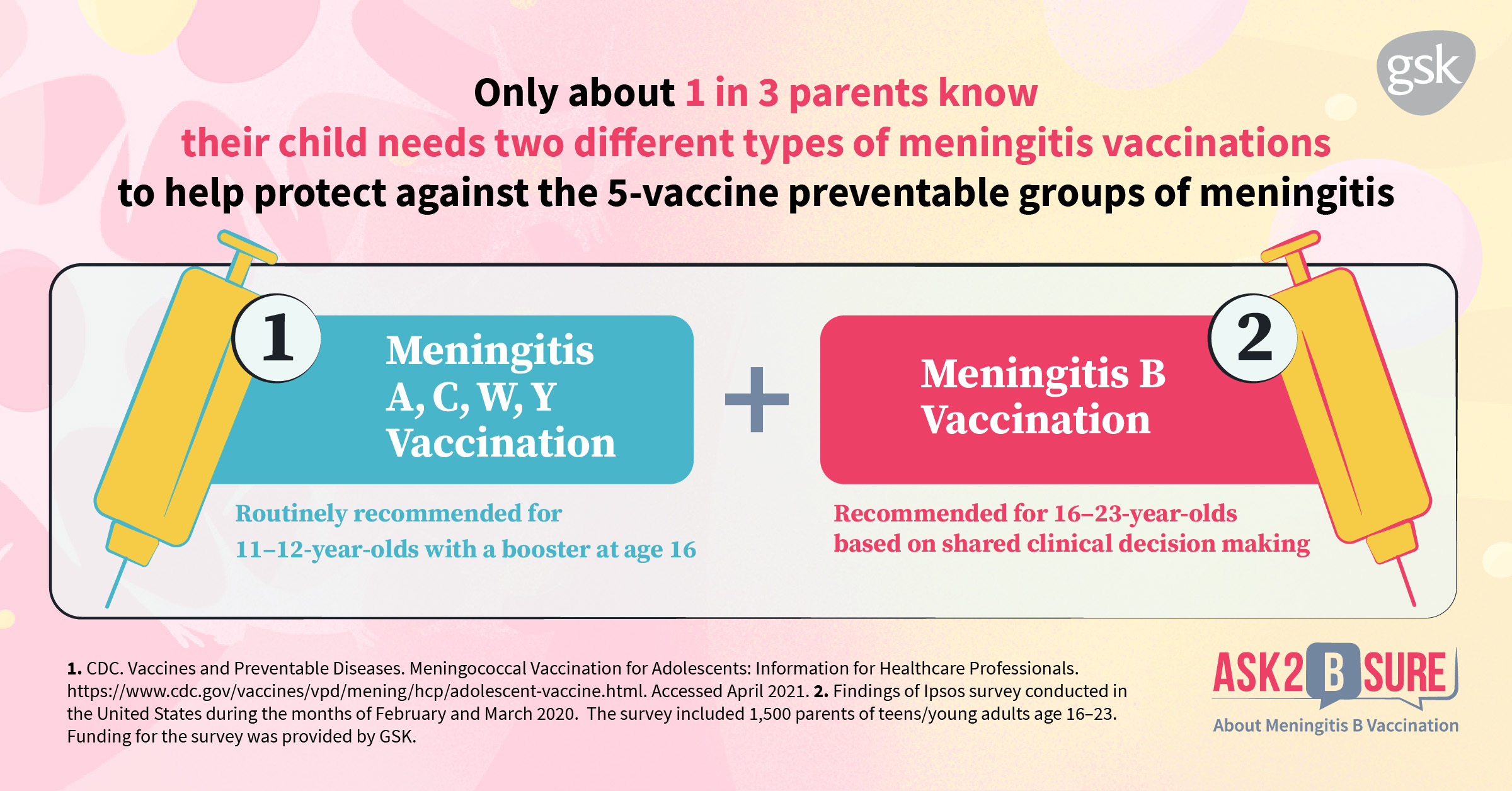This post is sponsored by GSK and its public health awareness campaign, “Ask2Bsure.”
Do you know if your teen or young adult has received meningitis B vaccination? Some doctors may not mention it and you may not know to ask.
While many of us are familiar with meningitis vaccination given to our kids at a younger age to help protect against meningitis A, C, W, and Y, there is a separate vaccination given to teens and young adults to help protect against meningitis B that they may miss.1
Meningococcal disease, known as meningitis, is an uncommon, but serious illness that can cause life-threatening complications or even death.1 Anyone can get meningitis, but rates of the disease reach a peak in adolescence, with the highest rates among teens and young adults 16 – 23 years old.2

As a mom, my top priority is protecting my kids, ages 11, 11, and 19. Like many kids, they received one type of meningitis vaccination (to help protect against meningitis ACWY) around 11 or 12 when they started middle school, and a booster when they turned (or will turn) 16.
My oldest started college last year, and we were fortunate enough to have a doctor who recommended meningitis B vaccination. I just learned that recent CDC data show that 7 out of 10 17-year-olds in the U.S. did not receive even one dose of meningitis B vaccination in 2020.2
Adolescents and young adults are at an increased risk for contracting meningitis because it can spread through certain common behaviors such as living in close quarters like college dormitories, coughing, sneezing, kissing, and sharing drinks, utensils, or smoking devices.3,4
Considering that teens and young adults are at an increased risk of contracting meningitis, it gives me peace of mind knowing that he has gotten this vaccination to help protect him from meningitis B while at college.5
If you are a parent, I encourage you to become more familiar with meningitis and take the necessary steps to help protect your children from this uncommon but potentially serious disease. Below, I’m sharing everything you need to know about meningitis, as well as a short video to help you become more informed.
What is Meningitis?
Meningococcal disease, known as meningitis, is an uncommon, but serious illness that can cause life-threatening complications or even death.6
What causes it?
Meningitis is caused by bacteria carried in the nose or back of the throat and can spread through saliva and close contact.
What are the symptoms?
Early symptoms of meningitis may be similar to those of the flu, but can progress quickly and can be fatal, sometimes within 24 hours.
Symptoms include sudden high fever, severe headache, body aches and chills, stiff neck, and a dark purple rash (typically on the torso, arms, or legs).6, 7, 8
What happens when you contract it?
Meningitis can attack the lining of the brain and spinal cord and, in some cases cause a serious infection of the blood (sepsis).7
Among those who contract meningitis, 1 in 10 will die, despite treatment.5
Up to 1 in 5 of meningitis survivors suffer long-term consequences, such as brain damage, amputations, hearing loss, and nervous system problems.5

Is My Child at Risk for Meningitis B?
Anyone can get meningitis, but rates of the disease reach a peak in adolescence, with the highest rates among teens and young adults 16–23 years old.5
Adolescents and young adults are at an increased risk for contracting meningitis because it can spread through behaviors such as living in close quarters, coughing, sneezing, kissing, and sharing drinks or utensils.6
Colleges are environments prone to the spread of meningitis B. From 2011 through March 2019, meningitis B caused all US college meningococcal outbreaks, which involved 13 campuses, 50 cases, and 2 deaths among an at-risk population of approximately 253,000 students.9

What Should I Know About the Meningitis B Vaccination?
There are two different types of vaccinations needed to help protect against the 5 vaccine-preventable groups of meningitis: one for groups A, C, W, and Y and another for group B.
Your young adult may have gotten a meningitis vaccine when they were younger, but meningitis B vaccination has only been available since 20141, and recent CDC data show that 7 out of 10 17-year-olds in the U.S. did not receive even one dose of meningitis B vaccination in 2020.10
According to the Centers for Disease Control and Prevention (CDC), vaccination is the best defense against meningococcal disease. Meningitis B vaccination may be administered to young adults ages 16 through 23 years old to help protect against meningitis B, based on “shared clinical decision-making,” a conversation between the parent and provider.
Even though teens and young adults may have received meningitis vaccination for groups A, C, W and Y when they were younger, there is a separate type of vaccination specifically for meningitis B, which has only been available since 2014, that they may miss.1
How Can I Ensure My Child is Vaccinated Against Meningitis B?
As a parent, asking your child’s doctor if they have received meningitis B vaccination is the best way to know for sure if they have received both types of vaccinations needed to help prevent the 5 vaccine-preventable groups of meningitis.
The more informed you are, the better equipped you will be to initiate important vaccination conversations with your child’s health care provider and ultimately make the best decisions to help protect them.
Learn more by watching this short video:
For each view of the video, GSK will donate $1, up to $10,000, to the Meningitis B Action Project, a project that was started by two mothers who lost their daughters to meningitis B and are now on a mission to educate fellow parents. Views will be counted through December 31, 2021.
Start the conversation with your child’s doctor about meningitis B to find out if they’re vaccinated. Visit Ask2Bsure.com for more information.
Citations: 1 - Vaccines and Preventable Diseases. Meningococcal Vaccination for Adolescents: Information for Healthcare Professionals. Centers for Disease Control and Prevention website. https://www.cdc.gov/vaccines/vpd/mening/hcp/adolescent-vaccine.html. Reviewed July 26, 2019. Accessed November 2020. 2- National, Regional, State, and Selected Local Area Vaccination Coverage Among Adolescents Aged 13–17 Years — United States, 2019. 2020; 69(33). Morbidity and Mortality Weekly Report. https://www.cdc.gov/mmwr/volumes/69/wr/pdfs/mm6933-H.pdf. Reviewed August 21, 2020. Accessed November 2020. 3 - Manual for the Surveillance of Vaccine-Preventable Diseases: Chapter 8: Meningococcal Disease. Centers for Disease Control and Prevention website. https://www.cdc.gov/vaccines/pubs/surv-manual/chpt08-mening.html. Reviewed December 2019. Accessed November 2020. 4 – Meningitis. Overview. Mayo Clinic website. https://www.mayoclinic.org/diseases-conditions/meningitis/symptoms-causes/syc-20350508. Updated October 1, 2020. Accessed November 2020. 5- Meningococcal Disease: Clinical Information. Centers for Disease Control and Prevention website. https://www.cdc.gov/meningococcal/clinical-info.html. Reviewed May 31, 2019. Accessed November 2020. 6 - Manual for the Surveillance of Vaccine-Preventable Diseases: Chapter 8: Meningococcal Disease. Centers for Disease Control and Prevention website. https://www.cdc.gov/vaccines/pubs/surv-manual/chpt08-mening.html. Reviewed December 2019. Accessed November 2020. 7- CDC. Meningococcal Disease: Signs and Symptoms. https://www.cdc.gov/meningococcal/about/symptoms.html. Accessed April 2021. 8 - Pelton SI. Meningococcal disease awareness: clinical and epidemiological factors affecting prevention and management in adolescents. J Adolesc Health. 2010;46:S9-S15 9 - Gary S Marshall, Amanda F Dempsey, Amit Srivastava, Raul E Isturiz, US College Students Are at Increased Risk for Serogroup B Meningococcal Disease, Journal of the Pediatric Infectious Diseases Society,piz024, https://doi.org/10.1093/jpids/piz024 10 - National, Regional, State, and Selected Local Area Vaccination Coverage Among Adolescents Aged 13–17 Years — United States, 2019. 2020; 69(33). Morbidity and Mortality Weekly Report. https://www.cdc.gov/mmwr/volumes/69/wr/pdfs/mm6933-H.pdf. Reviewed August 21, 2020. Accessed November 2020.



